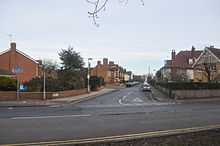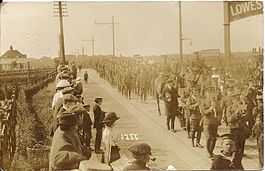Lowestoft North railway station
| Lowestoft North | |
|---|---|
|
The 4th Battalion Suffolk Regiment marching from Lowestoft North to its camp along the Yarmouth Road; the tram standards and rails of Lowestoft Corporation Tramways can be seen. | |
| Location | |
| Place | Lowestoft |
| Area | Waveney, Suffolk |
| Grid reference | TM546948 |
| Operations | |
| Original company | Norfolk and Suffolk Joint Railway |
| Post-grouping |
Norfolk and Suffolk Joint Railway Eastern Region of British Railways |
| Platforms | 2 (reduced to 1 in the 1960s) |
| History | |
| 13 July 1903 | Opened |
| 6 November 1967 | Closed to goods traffic |
| 4 May 1970 | Closed to passengers |
| Disused railway stations in the United Kingdom | |
|
Closed railway stations in Britain A B C D–F G H–J K–L M–O P–R S T–V W–Z | |
| UK Railways portal | |
Lowestoft North railway station was in Lowestoft, England. It closed in 1970.[1]
The station was located just to the east of the A12, opposite the Denes High School; a site which is now occupied by Beeching Drive.
History
Lowestoft North was opened on 10 July 1903 by the Norfolk and Suffolk Joint Railway as part of its line from Yarmouth to Lowestoft.[2][3][4][5] As the last Norfolk & Suffolk station on the line, it was situated 10 miles 11 chains (16.3 kilometres) from Yarmouth Beach railway station.[6] The station covered a large area and was provided with two long platforms lit by electric lamps in anticipation of large numbers of passengers.[7][8] The station was located immediately to the north of the Yarmouth Road and comprised imposing station buildings on either side of the tracks, which were connected by a footbridge.[9] On the Down side, there was a spacious goods yard with a weighing machine and cattle pens.[9] The station remained little changed during its lifetime.[10]
Before the line that served this station was built, it was intended for the line to branch off just to the south of Lowestoft North Station to a terminus station called Lowestoft Beach, on the Denes, because the owning company could not obtain powers to take the line into Lowestoft Central Station (then just called Lowestoft Station). This was resolved and the proposed Lowestoft Beach terminus and branch was never built.
The station became an important coal depot with the line dealing with 20,000 tons of coal a year.[11] It was also a popular location for the movement of troops by the military which had camps nearby on the North Denes and on what is now Corton Road playing field.[12] The March 1908 timetable shows three weekday afternoon/evening services from Lowestoft North to Yarmouth Beach; the journey time was 26 minutes.[13] The first service departed at 1317, arriving at Yarmouth Beach at 1343, then proceeding via North Walsham Town (1454), Melton Constable (1530), South Lynn (1656), Holbeach (1734), Bourne (1802) and terminating at Saxby (1845).[13]
The development of holiday camps along the Suffolk coast from the 1930s onwards brought lengthy trains to the Yarmouth-Lowestoft line.[14] In the 1950s, The Easterling departed from Liverpool Street at 1500 on summer Saturdays, travelling to Yarmouth South Town via Gorleston-on-Sea and Lowestoft North, its first stop being at Lowestoft Central where it reversed.[15] Each Saturday during the summer of 1957 the local passenger service was supplemented by two trains to Liverpool Street and four trains bringing passengers in the opposite direction.[14] There was also a service in each direction to Derby and Leicester, plus a through train to York.[14] For several years, Lowestoft North had a static camping coach in a siding; it was used as accommodation for holidaymakers.[16]
In September 1966, the line was singled and all intermediate stations became unstaffed halts.[17] From this point onwards, it became a deteriorating ghost line.[18] In the last few years before closure, the line became a long siding providing a skeleton passenger service which was very cheap to run and with no level crossings of any importance.[19] Once staff had been withdrawn, access to the station was via a side gate rather than through the booking hall which was locked out of use.[20] The station closed on 4 November 1970[2][3] and the next day Lowestoft North signal box also closed, the last Norfolk & Suffolk box still in use at the time.[21] The goods yard had already closed on 6 November 1967.[22]
| Preceding station | Disused railways | Following station | ||
|---|---|---|---|---|
| Corton Line and station closed |
Norfolk and Suffolk Joint Railway Yarmouth–Lowestoft Line |
Lowestoft Central Line closed, station open | ||
Present day

After closure of the line, the land in the vicinity of Lowestoft North was purchased for residential development.[23] Housing now completely covers the site,[8][24] but the memory of the line lives on as the roads have names associated with the railway, such as Beeching Drive.[23]
Part of the original route between Lowestoft Central and Lowestoft North, where the tracks ran mostly below street level in an open cutting, has been made into a non-vehicular public right-of-way known as the Great Eastern Linear Park. After a period during which the line was left unused, overgrown and partially flooded for many years after its closure, a 600 m (660 yd) section between the North Quay Retail Park and Marham Road was made into a cyclepath as part of phase 1 of the scheme which was completed in Spring 1998.[25] The second part of the route as far as Yarmouth Road was completed in Summer 2004 to create a 1,800 m (2,000 yd) corridor.[26]
The stationmaster's house has survived nearby on the corner of Station Road in a fairly unchanged state.[27] It resembles the stationmaster's house at Corton.[27]
References
Notes
- ↑ Subterranea Britannica: SB-Sites:Yarmouth South Town Station
- ↑ 2.0 2.1 Quick (2009), p. 260.
- ↑ 3.0 3.1 Butt (1995), p. 150.
- ↑ Body (1986), p. 109.
- ↑ Wrottesley (1970), p. 97.
- ↑ Wrottesley (1970), p. 196.
- ↑ Adderson & Kenworthy (2008), figs. XII and 52.
- ↑ 8.0 8.1 White (2004), p. 54.
- ↑ 9.0 9.1 Adderson & Kenworthy (2008), fig. XII.
- ↑ Adderson & Kenworthy (2008), fig. 52.
- ↑ Joby (1975), p. 30.
- ↑ White (2003), p. 51.
- ↑ 13.0 13.1 Wilkinson (2007), p. 31.
- ↑ 14.0 14.1 14.2 Adderson & Kenworthy (2008), fig. 53.
- ↑ Brodribb (2009), p. 219.
- ↑ Adderson & Kenworthy (2008), fig. 54.
- ↑ Joby (1975), p. 49.
- ↑ Joby (1975), p. 50.
- ↑ White (2004), p. 58.
- ↑ Adderson & Kenworthy (2008), fig. 55.
- ↑ Wrottesley (1970), p. 169.
- ↑ Clinker (1978), p. 90.
- ↑ 23.0 23.1 White (2004), p. 55.
- ↑ White (2003), p. 52.
- ↑ Waveney District Council (2 March 1999). "V26-1314: Adoption of Railpath Phase 1, Great Eastern Linear Park". Retrieved 2012-07-26.
- ↑ Great Yarmouth Town Centre Partnership (23 July 2004). "Cycle route nears completion". Retrieved 2012-07-26.
- ↑ 27.0 27.1 Adderson & Kenworthy (2008), fig. 56.
Sources
- Adderson, Richard; Kenworthy, Graham (November 2008). Branch Lines around Lowestoft: From Yarmouth to Beccles. Midhurst, West Sussex: Middleton Press. ISBN 978-1-906008-40-6.
- Body, Geoffrey (1986). Railways of the Eastern Region 1. Wellingborough, Northants: Patrick Stephens. ISBN 0-850597-12-9.
- Brodribb, John (2009). The Main Lines of East Anglia. Hersham, Surrey: Oxford Publishing Co. ISBN 978-0-86093-629-9.
- Butt, R. V. J. (1995). The Directory of Railway Stations: details every public and private passenger station, halt, platform and stopping place, past and present (1st ed.). Sparkford: Patrick Stephens Ltd. ISBN 1-8526-0508-1. OCLC 60251199.
- Clinker, C.R. (October 1978). Clinker's Register of Closed Passenger Stations and Goods Depots in England, Scotland and Wales 1830-1977. Bristol: Avon-Anglia Publications & Services. ISBN 0-905466-19-5.
- Joby, R.S. (1975) [1970]. The Norfolk & Suffolk Joint Railways Committee. Norwich: Klofron. OL 14612730M.
- Quick, Michael (2009) [2001]. Railway passenger stations in Great Britain: a chronology (4th ed.). Oxford: Railway and Canal Historical Society. ISBN 978 0 901461 57 5. OCLC 612226077.
- White, Malcolm R. (2004). Rails to the Coast. Lowestoft: Coastal Publications. ISBN 0-954732-30-8.
- White, Malcolm R. (2003) [2002]. The Lowestoft Train. Lowestoft: Coastal Publications. ISBN 0-953248-56-9.
- Wilkinson, E. (2007). Operation Norfolk. Caernarvon: Xpress Publishing. ISBN 978-1-90105-632-7.
- Wrottesley, A.J.F. (1970). The Midland & Great Northern Joint Railway. Newton Abbot, Devon: David & Charles. ISBN 0-7153-4340-8.
External links
- Lowestoft North station on 1946 O.S. map
- Images of stationmaster's house
- Image of station
- Image of station
